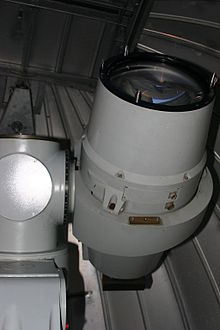BMK 75
The BMK 75 (abbreviation: B alli tables M esskammer 75 ) from Zeiss Oberkochen is the most technically demanding satellite camera . It is used to take photographs of artificial earth satellites - from the earth - against the background of the starry sky . There is also a version with a focal length of 45 cm called BMK 45.
The measuring camera came on the market around 1970 and was specially developed for satellite geodesy and astrometry . It has a focal length of 75 cm (which the name suggests) and an aperture ratio of 1: 2.5. The camera lens has an aperture of 30 cm, which means that the BMK-75 is almost as bright as the NASA Baker-Nunn camera . It has two major advantages over other satellite cameras:
- the (unavoidable) distortion of the lens is only 1–2 µm, which makes a special distortion correction unnecessary due to the similarly high measurement accuracy
- an ingenious system for rapid plate change , which allows numerous recordings during a single satellite pass.
The mount of the camera can azimuthal ( ALTAZ ) or equatorial be executed. The former is cheaper for ballistic cameras , the latter for astrometry because of the tracking adapted to the stars .
Among the measuring chambers supplied, those of the fundamental stations in Wettzell (Bavarian Forest) and at Grazer Lustbühel (Styria) are among the cameras with the highest number of observations worldwide. The cameras were delivered until around 1985, some of them have since been converted from photo plates to digital ( CCD sensors ), the one in Graz is also used for astronomy , for example for the systematic search for minor planets .
swell
- Günter Seeber (1989): Satellite Geodesy (Chapter 5.1), de Gruyter, Berlin 1989
- University of Münster (2009): GPS in Geosciences - Optical Global Triangulation
